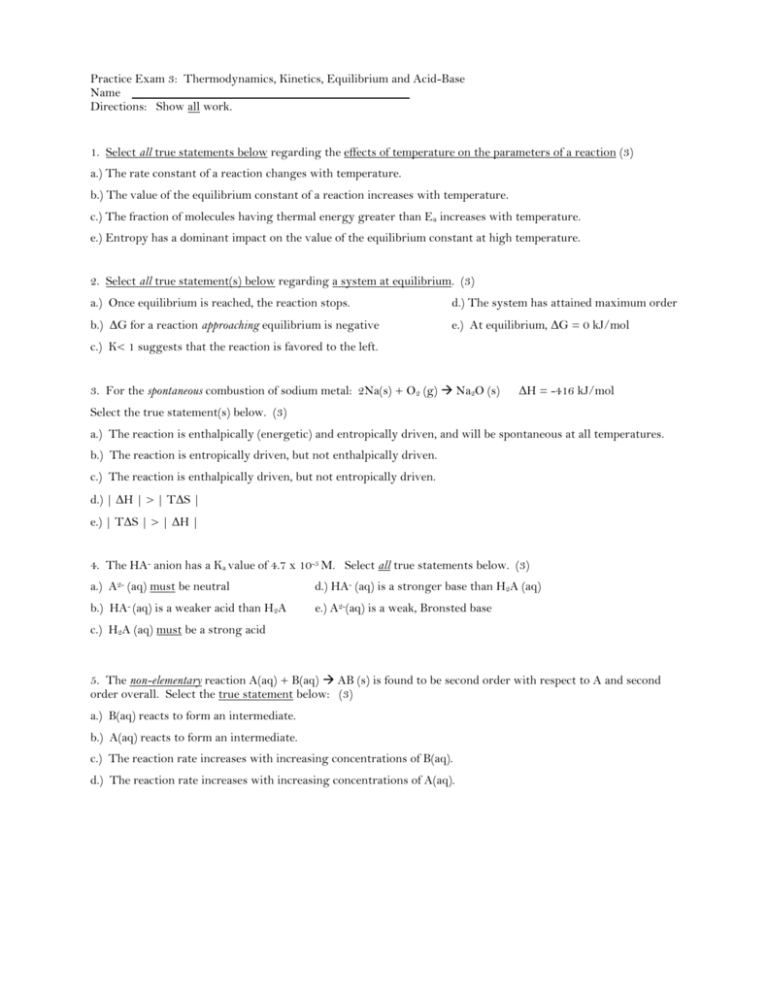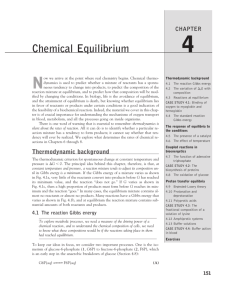Practice Exam 3: Thermodynamics, Kinetics, Equilibrium and Acid
advertisement

Practice Exam 3: Thermodynamics, Kinetics, Equilibrium and Acid-Base Name Directions: Show all work. 1. Select all true statements below regarding the effects of temperature on the parameters of a reaction (3) a.) The rate constant of a reaction changes with temperature. b.) The value of the equilibrium constant of a reaction increases with temperature. c.) The fraction of molecules having thermal energy greater than Ea increases with temperature. e.) Entropy has a dominant impact on the value of the equilibrium constant at high temperature. 2. Select all true statement(s) below regarding a system at equilibrium. (3) a.) Once equilibrium is reached, the reaction stops. d.) The system has attained maximum order b.) ΔG for a reaction approaching equilibrium is negative e.) At equilibrium, ΔG = 0 kJ/mol c.) K< 1 suggests that the reaction is favored to the left. 3. For the spontaneous combustion of sodium metal: 2Na(s) + O2 (g) Na2O (s) ΔH = -416 kJ/mol Select the true statement(s) below. (3) a.) The reaction is enthalpically (energetic) and entropically driven, and will be spontaneous at all temperatures. b.) The reaction is entropically driven, but not enthalpically driven. c.) The reaction is enthalpically driven, but not entropically driven. d.) | ΔH | > | TΔS | e.) | TΔS | > | ΔH | 4. The HA- anion has a Ka value of 4.7 x 10-5 M. Select all true statements below. (3) a.) A2- (aq) must be neutral d.) HA- (aq) is a stronger base than H2A (aq) b.) HA- (aq) is a weaker acid than H2A e.) A2-(aq) is a weak, Bronsted base c.) H2A (aq) must be a strong acid 5. The non-elementary reaction A(aq) + B(aq) AB (s) is found to be second order with respect to A and second order overall. Select the true statement below: (3) a.) B(aq) reacts to form an intermediate. b.) A(aq) reacts to form an intermediate. c.) The reaction rate increases with increasing concentrations of B(aq). d.) The reaction rate increases with increasing concentrations of A(aq). 6. The combustion of iron metal leads to the formation of rust, Fe2O3(s). This is a spontaneous process. What are the signs of ΔG, ΔH and ΔS? What drives the reaction? Under what circumstance would the reaction not be spontaneous? (7) 7. In terms of G and S, explain why systems approach equilibrium (4 sentences or less). You may include a figure if you deem this helpful. (5) 8. Based on the definition of “irreversible” from thermodynamics, explain why spontaneous reactions are irreversible (3 sentences or less). (5) 9. Use the data shown to the right for the reaction H2O 2H + O to answer the following questions. 1 Write the rate law of the reaction, including k. Show units. (6) 1/[H2O] 0.8 What is the rate of the reaction at t= 25 sec? (7) 0.6 0.4 0.2 0 0 5 10 15 Time (sec) 10. The pKa values of oxalic acid, H2C2O4, are 1.25 and 3.81. Write the forms of the molecule, including charge, that you would expect to find at the following pH values. Specify relative abundances. pH = 9 pH = 2.4 pH = 1 pH = 4 11. Consider the reaction between hydrofluoric acid (aq) and ammonia (aq) T = 25oC Initially, [hydrofluoric acid]=1M and [ammonia] = 0.74M. The reaction is allowed to proceed to equilibrium, at which point, [hydrofluoric acid]=0.4M and [ammonia] = 0.14M. a.) Write out the full, balanced reaction. Determine the value of K. (5) b.) Now, the system is purged, causing the ammonia concentration to drop by 31%. Determine ΔG and the new equilibrium concentrations. (x values are not required. 1.5% bonus credit will be given for a correct value) (10) 20 12. Determine the pH and [H3O+] of a 0.038M solution of methylamine, CH3NH2(aq) given that the Kb of methylamine is 13. Sketch a reaction curve for a reaction having an activation energy of 500 KJ/mol and ΔH0rxn = +200 KJ/mol. The reaction progress should go on the x-axis. Also, label the transition state. (4)Equations and constants ΔGo = ΔHo -TΔSo ΔG0 = -RT ln K (R = 8.314 J/mol K) pH = -log [H3O+] ΔG = RT ln (Q/K) pH + pOH = 14 ln (K2/K1) = (ΔH0/R)( – pKa = -log Ka ) 1st order: ln [A]t = -kt + ln [A]o 2nd order: 1/[A]t = kt + 1/[A]o k = Ae-Ea/RT ln K = -ΔH/(RT) + ΔS/R eln(x) = x 10log(x) = x 10-pH = [H3O+]


![CHEM 1520 SI MON, TUES, & WEDNES 1.Calculate [H3O+] in a](http://s3.studylib.net/store/data/007346334_1-b78d73402f58153c92290299886ff084-300x300.png)





